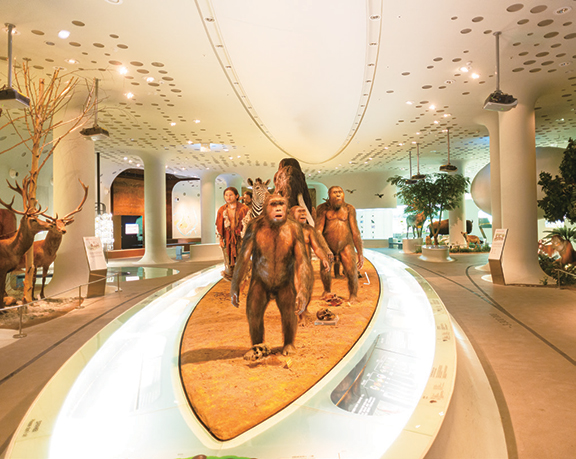-
 2023. February VOL. 659
2023. February VOL. 659
Yeoncheon County in Gyeonggi Province is a city of rivers. Two big rivers flow across the county from north to south without being halted or blocked by anything natural or artificial. One is the Imjingang River that flows down from north to join the Hangang River. The other one is the Hantangang River that also starts in the north and meets Imjingang River in Dogampo. Imjingang River runs along the west of Yeoncheon County. Hantangang River passes through Cheolwon County and Pocheon City and weaves its way through the country to reach the southwestern tip of the county. Hantangang Dam was built in the mid region of Hantangang River in 2016.
Normally, the dam designed for flood control does not store water, leaving the natural water flow intact, but it stores water underground temporarily to control the water flow during the monsoon season. So it is a gate as well as a dam, and is closed and open at the same time.
The dam has a total of 11 flood gates. There are five emergency spillways that provides the controlled release of water downstream in case of an emergency and two permanent spillways designed to control the dam’s outflow during floods. There are two discharge pipes and four ecological corridors set up to minimize damages to ecosystem and the environment. The gateless discharge pipes allow water to run through the dam, thus preserving the natural conditions of the river even after the dam was built. If you look down from the Hanyeoul Bridge located 600m down the river from the dam, you can get a much better view of the dam’s eco-friendly design. It also blends nicely with the beautiful gorges that unfold along the river.
The Hantangang River was created through a unique formation process that sets it apart from other rivers given that it was formed as a result of multiple volcanic eruptions that had occurred in and around Orisan Mountain in Pyeonggang County between around 500,000 years and 120,000 years ago. Back then, the hot lava that gushed from the volcanoes flowed down the river and reached Imjinggang River, filling the low areas on its path and creating giant gorges. Then, the Hantangang River ran over the solidified lava, creating a lava plateau. Subsequently, the plateau was eroded by river water, rains and winds over time to form what is known as Jusanjeolli Cliff, columnar joints that stretch 120km from Chugaryeong to Jeongok-ri. The marvelous ‘feats of time’ have resulted in a collection of geological features in different shapes and sizes including Jusangjeolli Cliff, Pansangjeolli Cliff, fold strutures and horizontal joints, which have been collectively designated as ‘Hantangang River Global Geopark.’
It is the 4th geopark in South Korea designated as a global geopark in 2020, following Jeju Island, Cheongsong County and Mudeungsan Mountain. The park encompasses 24 geological attractions on a total area of 1,165㎢ in Yeoncheon County, Pocheon City and Cheolwon County, with ten of them being located in Yeoncheon County.
They include Jaein Waterfall, Auraji Pillow Lava(located in Pocheon City but clearly visible from Yeoncheon County), Jeongok-ri relics stratum, Jwasang Rock, Baeguiricheung, Dongmakgol Tuff, Chatancheon Jusangjeolli, Imjingang River Jusangjeolli, Dangpo Fortress Jusangjeolli, Eundae-ri Pansangjeolli(sheeting joints) and fold structures. Four of these sites which are located within a 6k radius of the Hantangang Dam, i.e., Jaein Waterfall Baeguiricheung, Pillow Lava and Jwasang Rock are grouped into a route, making it convenient and enjoyable for visitors to view.




Winter in Yeoncheon starts with cranes and ends with reverse icicles. Different kinds of cranes including white-naped cranes and hooded cranes come to Yeoncheon in November. They spend winter in the civilian control line in Yeoncheon, feeding on grains of Job’s tears and fly back to Siberia around March the following year. Their main habitats are located between Janggunyeoul to Pilseung Bridge of the Imjingang River within the civilian control line.
However, Pilseung Bridge is a rather challenging section of the route so you are advised to park your cars near the Crane Observatory installed at Janggunyeoul or Bingaeyeoul to watch the cranes. If you are lucky, you can see a number of cranes flying, walking or resting in their elegant and dignified style.
Another winter treasure of Yeoncheon is the “Reverse Icicle Tunnel” located at the foot of Godaesan Mountain in Shinseo-myeon. There are crystal-shaped icicles rising high from the ground of the tunnel, and ice columns ranging from 2-3cm to as tall as 1m fill its inside. These reverse icicles are formed as water droplets freeze as soon as they hit the ground, while differences in temperature, pressure or energy between ground and underground water push underground water up above-ground, which then freezes into icicles. These reverse icicles are formed between mid-December to February or March. Please be aware that you need to take extra caution when entering the tunnel due to the narrow road leading to the tunnel.



Dangpo Fortress was built as one of the defense lines during the Goguryeo period. Seated on a 13m cliff in a tall triangle shape, the fortress combines only the strengths of an earthen fortress and a stone fortress marked by flexbility and durability. Fortresses are usually built in a place with an open view from all four directions. A great landscape view has made the fortress a hot spot on social media, where many people visit and take photos. Visitors particularly like to snap photos with a hackberry tree on the bastion in the background.
![]() Address: 778 Dongyi-ri, Misan-myeon, Yeoncheon-gun, Gyeonggi-do
Address: 778 Dongyi-ri, Misan-myeon, Yeoncheon-gun, Gyeonggi-do

It was interesting to learn that the museum has earned the nickname ‘Dolbak’, which means a museum featuring rocks. The most prominent item on display is the double-sided handaxe called Acheulean-type stoneware. This stone axe that was discovered in Jeongok-ri in 1978 marked a watershed in the global history of archeology and changed the previously Eurocentric map of the Paleolithic period. The stone axe shows that not only the Acheulean but also Jeongok-ri possessed stone-processing technology that was considered as state-of-the art technology of the time. Also on display are models of the early humans that lived in the area as well as stoneware including fist pricks and scrapers. The museum is closely related to Jeongok-ri prehistoric sites, the oldest Paleothlic site on the Korean Peninsula.
![]() Address: 443 bun-gil 2 Pyeonghwa-ro, Jeonggok-eup, Yeoncheon-gun, Gyeonggi-do
Address: 443 bun-gil 2 Pyeonghwa-ro, Jeonggok-eup, Yeoncheon-gun, Gyeonggi-do
![]() Tel : 031-830-5600
Tel : 031-830-5600

Located within the civilian control line, it is the northernmost gallery in South Korea and the first art space built within the civilian control line. The indoor exhibition halls are great, but what is more impressive is the huge façade works made of photos of the Imjingang River Jusangjeolli that decorate the exterior of the gallery. The former Unification Security Exhibition Hall has been remodeled into the gallery which connects to ‘Imjingang River Peace Wetlands’ and the suspension bridge. You must present your ID to enter the civilian control line. Since admission can be restricted for military exercises and other reasons without prior notice, please call and check in advance.
![]() Address: 885 Gunjung-ro, Jung-myeon, Yeoncheon-gun, Gyeonggi-do
Address: 885 Gunjung-ro, Jung-myeon, Yeoncheon-gun, Gyeonggi-do
![]() Tel : 031-834-4100
Tel : 031-834-4100
